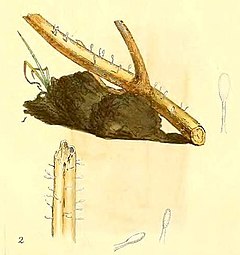Typhula quisquiliaris
| Typhula quisquiliaris | |
|---|---|

| |
| Typhula quisquiliaris, as illustrated by James Sowerby | |
| Scientific classification | |
| Domain: | Eukaryota |
| Kingdom: | Fungi |
| Division: | Basidiomycota |
| Class: | Agaricomycetes |
| Order: | Agaricales |
| Family: | Typhulaceae |
| Genus: | Typhula |
| Species: | T. quisquiliaris
|
| Binomial name | |
| Typhula quisquiliaris (
Henn. 1896 | |
| Synonyms[1][2] | |
Typhula quisquiliaris,
Taxonomy
Typhula quisquiliaris was first described by
Description
| Typhula quisquiliaris saprotrophic |
|---|
Typhula quisquiliaris produces fruit bodies in the form of clubs. Each fruit body consists of a single distinct "stem" and "head",[6] and measures up to 7 mm (0.3 in) in height.[7] The surface of the head is smooth and white,[6] and measures 1.5 to 4 mm (0.06 to 0.2 in) by 1 to 2.5 mm (0.04 to 0.1 in). The rounded stem is infertile, and of a similar colour to the head. However, it has a very fine downy covering, and is somewhat translucent. The stem measures from 0.3 to 0.4 mm (0.01 to 0.02 in) in width. The stem attaches to sclerotium which is buried into the branch from which the fruit body grows.[6]
Microscopic characteristics
Typhula quisquiliaris spores are narrowly
Habitat and distribution
Typhula quisquiliaris fruit bodies are typically found in rows, growing from plant
References
- ^ a b c d "Typhula quisquiliaris (Fr.) Henn. 1896". MycoBank. International Mycological Association. Retrieved 29 July 2011.
- ^ "Typhula quisquiliaris synonymy". Species Fungorum. CAB International. Retrieved 29 July 2011.
- ^ "Clavaria obtusa Pers. 1797". MycoBank. International Mycological Association. Retrieved 2 August 2011.
- ^ a b c d Rea, Carleton (1922). British Basidiomycetaceae: a Handbook to the Larger British Fungi. Cambridge, UK: Cambridge University Press. p. 205.
- ^ Andrews, Ethan Allen; Freund, William (1876). A Copious and Critical Latin-English Lexicon. Harper & Bros. p. 1259. Retrieved 2 August 2011.
quisquiliae, arum ... The waste or refuse of any thing, the droppings of trees, sweepings, offscourings, rubbish, filth
- ^ ISBN 978-0-00-723224-6.
- ^ ISBN 978-0-412-36970-4.
